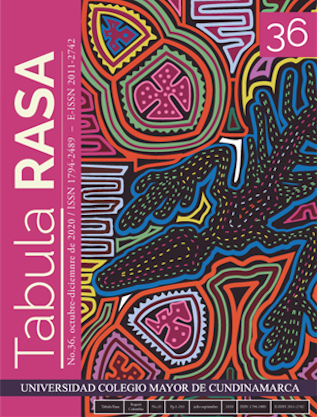Blood and the Logic of Gift among Pume of Venezuela. A Feminine Model of Cosmos
Sangre y lógica del don entre los indígenas pumé de Venezuela. Un modelo femenino del cosmos
Show authors biography
This paper examines the dominant modes of relatedness among Pumé Indians through the circulation of female blood. The logic of Gift intervenes in the relations between Pumé beings —humans, animals, and spirits sharing soul and blood–, while predation dominates their relations with other beings that are alien to Pumé society, namely the “spirits of the savanna landscape”, the “spirits of the depths of the earth”, and Whites. Mythology supports the structuring place of the feminine in the constitution of the order of cosmos and thus bleeding works as an operator of social relations.
Article visits 139 | PDF visits 75
Downloads
- Århem, K., Cayón, L., Angulo, G. & García, M. (2004). Etnografía Makuna. Tradiciones, relatos y saberes sobre la gente del agua. Bogotá: Instituto Colombiano de Antropología e Historia.
- Belaunde, L.E. (2008). El recuerdo de Luna. Género, sangre y memoria entre los pueblos amazónicos. Lima: Centro Amazónico de Antropología y Aplicación Práctica, CAAAP.
- Brown, M. (1986). Tsewa’s gift. Magic and Meaning in Amazonian Society. Tuscaloosa, Alabama: The University of Alabama Press.
- Conklin, B. (2001). Women’s Blood, Warriors’. Blood and the Conquest of Vitality in Amazonia. En Th. A. Gregor & D. Tuzin (Eds.). Gender in Amazonia and Melanesia. An Exploration of Comparative Method, (pp.141-171). Berkeley: University of California Press.
- Crocker, J. C. (1985). Vital Souls. Bororo Cosmology, Natural Simbolism and Shamanism. Tucson: University of Arizona Press.
- Descola, P. (2005). Par delà de la nature et la Culture. Paris: Gallimard.
- Gragson, T. (1992). The Use of Palma by the Pume Indians of Southwestern Venezuela. Principes, 36(3), 133-142. https://documentacao.socioambiental.org/documentos/M6D00028.pdf
- Guzmán Gallegos, M.A. (1997). Para que la yuca beba nuestra sangre. Trabajo, género y parentesco en una comunidad quichua de la Amazonia ecuatoriana. Quito: Abya Yala. https://digitalrepository.unm.edu/cgi/viewcontent.cgi?article=1067&context=abya_yala
- Lévi-Strauss, C. (1971). L’Homme Nu. Mythologiques IV. Paris: Plon.
- Martínez Mauri, M. (2019). What makes the Guna dule? Reflections on the interiority and physicality of people, humans and non-humanas. The Journal of Latin America and Caribbean Anthropology, 24(1), 52-69. https://doi.org/10.1111/jlca.12310
- Mitrani, P. (1988). Los pumé (yaruro). En W. Coppens (Ed.), Los aborígenes de Venezuela, Volumen III (pp.147-213). Caracas: Fundación La Salle de Ciencias Naturales / Monte Ávila.
- Mitrani, P. (1978). Salud y enfermedad en la concepción yaruro: ensayo de antropología médica. Montalbán, 8, 329-390.
- Obregón Múñoz, H.; Castillo, C. & Díaz Pozo, J. (1986). Las palabras de la Creadora. Maracaibo: UPEMAR.
- Obregón Múñoz, H. & Díaz Pozo, J. (1993). La diosa del pulgar preñado. Narrativas yaruras. Caracas: Monte Ávila Editores.
- Orobitg, G. (2018). Mujeres en el origen. Una distribución pumé de los seres del cosmos
- (Venezuela), AIBR. Revista de Antropología Iberoamericana, 13(2), 169-188
- Orobitg, G. (2015). Lamento ritual de las mujeres pumé. Un ensayo sobre emotividad y política. En M. Gutiérrez Estévez & A. Surrallés (Eds.). Retóricas de los sentimientos. Etnografías amerindias, (pp.125-152). Madrid/Frankfurt: Iberoamericana/Vervuert.
- Orobitg, G. (1999). El cuerpo como lenguaje. La posesión como lenguaje del género entre los indígenas pumé de los Llanos de Apure (Venezuela). Ankulegui: gizarte antropologia aldizkaria, Extra 0, 71-82.
- Pitarch, P. (2012). The Two Maya Bodies: An Elementary Theory of Tzeltal Personhood. Ethnos. Journal of Anthropology, 77(1), 93-114. https://doi.org/10.1080/00141844.2011.590217
- Santos-Granero, F. (2012). Beinghood and People-making in Native Amazonia. A constructional approach with perspectival coda. HAU: Journal of Ethnographic Theory, 2(1), 181-211. https://doi.org/10.14318/hau2.1.010
- Shiratori, K. (2018). O olhar envenenado: da metafisica vegetal Jamamadi, Media Punus, AM (tesis doctoral). PPGAS, Museu Nacional-Universidade Federal do Rio de Janeiro, Rio de Janeiro.
- Surrallés, A. (2003). Au coeur du sens. Perception, affectivité, action chez les Candoshi. Paris: CNRS Éditions/Éditions de la Maison des Sciences de l’Homme.
- Viveiros de Castro, E. (2004) [1996]. Perspectivismo y multinaturalismo en la América Indígena. En A. Surrallés & P. García Hierro (Eds.). Tierra Adentro: territorio indígena y percepción del entorno (pp. 37-80). Copenhague: IWGIA.
- Wilbert, J. & Simoneau, K. (Eds.). (1990). Folk Literature of The Yaruro Indians. Los Angeles: UCLA, Latin American Center Publications, University of California.
- Yu, P. (1997). Hungry Lighting. Notes of a Woman Anthropologist in Venezuela. Albuquerque: University of New Mexico Press.









